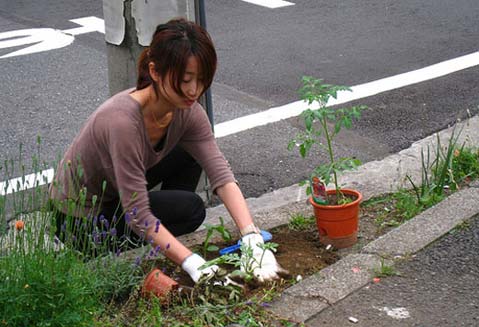Guerrilla Gardening
Turning Vacant Lots into Green Oasis

In the wee hours, there is a growing cadre of secret gardeners. Vacant lot by lot they are trying to bring a little beauty to neighborhoods all across the nation. Parking strips are being transformed from weedy patches to green and orderly natural habitats. Many of these guerrilla gardeners are working under cover because it is part of the fun, but others acknowledge that they skate just outside the law at times.
The instances of land owners razing the hard fought gains of these clandestine landscape improvements are legion. Governments don’t always like citizen-initiated and realized projects; they insist on everyone going through channels. Even many private landowners may be threatened by the actions of these gentle rebels. They worry about liability and other legal issues that could result from unsanctioned actions. The truly evangelical garden guerrillas will not be deterred, so don’t be surprised if that dull corner of your neighborhood suddenly starts sprouting a pleasant mix of wildflowers.
So, what should a guerrilla gardener plant? It will certainly depend on where in the world they are working. In general, though, anyone thinking of trying on the role of deity should take into account several factors. How much rain will fall after the initial planting event to keep the plants growing? What kind of soil will their roots encounter? Is there sufficient sunshine or is this one of those dark alleys between tall buildings or fences? If the plants survive, will they escape and become invasive throughout the area? Success will depend on addressing each of these points and perhaps other factors, such as what debris or toxic elements may have been left from former activities on the site.
Guerrilla gardeners are, of course, to be commended. Many of them have made a very real difference in their neighborhoods. Tossing a peach pit or lemon pip in a suitable site can result in free food for passersby for years. Native wildflowers, which may even have lived in the area before humans invaded, could easily make a comeback with a little encouragement. And the mitigation of urban warming from too much concrete and asphalt by plants shading and cooling the air is proven. Other effects on the environment are also salutary, starting with an increase in carbon dioxide sequestration and oxygen production. The impact on humans is not to be denied, either. Study after study correlate the positive effects of greening neighborhoods with the decrease in crime and unsociable activities.
Some transformations are very orchestrated, with hauling of garbage, tilling of the soil, and actual planting of seedlings or seeds. Other methodologies may also be employed. A well-tested method of creating small balls of soil, nutrients, and seeds that can be tossed over the fence without much effort has proven very effective. These seed balls or seed bombs protect the seeds from birds, rodents, and insects and give them the perfect recipe for success. If made properly, they break down after a storm or two and support the germination and early growth of a variety of plants. One of the best parts is that they can be made cheaply and easily and tailored to any site.
March Tips
• Get those hedges back in shape. Shear as much as is needed to create crisp edges and corners. Spring growth will soon clothe them in green again.
• Start first plantings of tomatoes and peppers (eggplant, too). Transplant out when soil has finally warmed in six weeks or so.
• Hang pheromone baited sticky traps in apples to catch coddling moths just as blossoms open and yellow sticky cards in whitefly-prone species.



